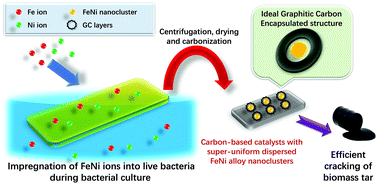当前位置:
X-MOL 学术
›
Green Chem.
›
论文详情
Our official English website, www.x-mol.net, welcomes your feedback! (Note: you will need to create a separate account there.)
Graphitic carbon embedded with Fe/Ni nano-catalysts derived from bacterial precursor for efficient toluene cracking
Green Chemistry ( IF 9.8 ) Pub Date : 2020/02/18 , DOI: 10.1039/c9gc03357b Shifei Kang 1, 2, 3, 4 , Maofen He 1, 2, 3, 4 , Chaochuang Yin 1, 2, 3, 4, 5 , Haiyang Xu 5, 6, 7, 8 , Qing Cai 1, 2, 3, 4 , Yangang Wang 5, 6, 7, 8 , Lifeng Cui 1, 2, 3, 4
Green Chemistry ( IF 9.8 ) Pub Date : 2020/02/18 , DOI: 10.1039/c9gc03357b Shifei Kang 1, 2, 3, 4 , Maofen He 1, 2, 3, 4 , Chaochuang Yin 1, 2, 3, 4, 5 , Haiyang Xu 5, 6, 7, 8 , Qing Cai 1, 2, 3, 4 , Yangang Wang 5, 6, 7, 8 , Lifeng Cui 1, 2, 3, 4
Affiliation

|
The environmentally-harmful by-product – biomass tar – is the major obstacle during biomass gasification, which produces synthetic gas as a clean energy source from agricultural waste or other bio-wastes. The highly-dispersed Fe/Ni-based nano-catalysts are of great research interest because of their great catalytic performance for catalytic biomass tar cracking. Supported Fe/Ni alloy catalysts were recognized as promising tar-cracking catalysts with the ability of redox enhancement and carbon deposition prevention. However, the controllable synthesis of highly-dispersed Fe/Ni nano-catalysts with high activity and stability remains a huge challenge. In this work, highly-dispersed FeNi alloy catalysts embedded in graphitic carbon (BC-FeNi) were successfully synthesized by simple calcination of a bacterial precursor, which can be easily harvested by collecting non-pathogenic bacteria in a Fe/Ni ion enriched liquid medium. The bacteria served as a carbon source and helped to uniformly distribute the iron–nickel ions in the precursor for subsequent preparation of highly-dispersed FeNi catalysts. Transmission electron microscopy showed the BC-FeNi contained well-dispersed iron-nickel nanoparticles with sizes of 3–10 nm in a mesoporous graphitic carbon matrix, which were beneficial for the protection of metal nanoparticles against coking and thus were highly desirable for catalytic biomass tar cracking. The conversion rate of the biomass tar model compound – toluene by BC-FeNi nano-catalysts was 82.6% at 700 °C and 95.8% at 800 °C, which were significantly superior over the control sample supported by active carbon. Noticeably, the metal loading (1.01 wt%) in the bacteria-derived BC-FeNi catalysts was very lower compared to previous studies using other synthetic methods (usually >10 wt%). This unique nature grants that the bacterial method may enable the facile design and synthesis of other types of practical nano-materials.
中文翻译:

嵌入有细菌前体的Fe / Ni纳米催化剂的石墨化碳可有效裂解甲苯
对环境有害的副产品-生物质焦油-是生物质气化过程中的主要障碍,该过程会从农业废弃物或其他生物废物中产生合成气作为清洁能源。高分散的Fe / Ni基纳米催化剂由于其对催化生物质焦油裂解的出色催化性能而具有很大的研究兴趣。负载型Fe / Ni合金催化剂被公认为具有改善氧化还原和防止积碳的有希望的焦油裂解催化剂。然而,具有高活性和稳定性的高分散性Fe / Ni纳米催化剂的可控合成仍然是一个巨大的挑战。在这项工作中,通过简单煅烧细菌前体,成功合成了嵌入石墨碳中的高分散FeNi合金催化剂(BC-FeNi),通过在富含Fe / Ni离子的液体培养基中收集非致病细菌,可以很容易地收获这些细菌。细菌充当碳源,并有助于将铁-镍离子均匀分布在前体中,以用于随后制备高度分散的FeNi催化剂。透射电子显微镜显示,BC-FeNi在介孔石墨碳基质中包含3–10 nm尺寸的分散良好的铁镍纳米颗粒,有利于保护金属纳米颗粒免于焦化,因此非常适用于催化生物质焦油开裂。BC-FeNi纳米催化剂对生物质焦油模型化合物-甲苯的转化率在700°C下为82.6%,在800°C下为95.8%,明显优于活性炭负载的对照样品。明显地,金属负载(1。与以前使用其他合成方法进行的研究(通常> 10 wt%)相比,细菌衍生的BC-FeNi催化剂中的01 wt%含量要低得多。这种独特的性质使细菌方法可以实现其他类型的实用纳米材料的简便设计和合成。
更新日期:2020-03-24
中文翻译:

嵌入有细菌前体的Fe / Ni纳米催化剂的石墨化碳可有效裂解甲苯
对环境有害的副产品-生物质焦油-是生物质气化过程中的主要障碍,该过程会从农业废弃物或其他生物废物中产生合成气作为清洁能源。高分散的Fe / Ni基纳米催化剂由于其对催化生物质焦油裂解的出色催化性能而具有很大的研究兴趣。负载型Fe / Ni合金催化剂被公认为具有改善氧化还原和防止积碳的有希望的焦油裂解催化剂。然而,具有高活性和稳定性的高分散性Fe / Ni纳米催化剂的可控合成仍然是一个巨大的挑战。在这项工作中,通过简单煅烧细菌前体,成功合成了嵌入石墨碳中的高分散FeNi合金催化剂(BC-FeNi),通过在富含Fe / Ni离子的液体培养基中收集非致病细菌,可以很容易地收获这些细菌。细菌充当碳源,并有助于将铁-镍离子均匀分布在前体中,以用于随后制备高度分散的FeNi催化剂。透射电子显微镜显示,BC-FeNi在介孔石墨碳基质中包含3–10 nm尺寸的分散良好的铁镍纳米颗粒,有利于保护金属纳米颗粒免于焦化,因此非常适用于催化生物质焦油开裂。BC-FeNi纳米催化剂对生物质焦油模型化合物-甲苯的转化率在700°C下为82.6%,在800°C下为95.8%,明显优于活性炭负载的对照样品。明显地,金属负载(1。与以前使用其他合成方法进行的研究(通常> 10 wt%)相比,细菌衍生的BC-FeNi催化剂中的01 wt%含量要低得多。这种独特的性质使细菌方法可以实现其他类型的实用纳米材料的简便设计和合成。



























 京公网安备 11010802027423号
京公网安备 11010802027423号